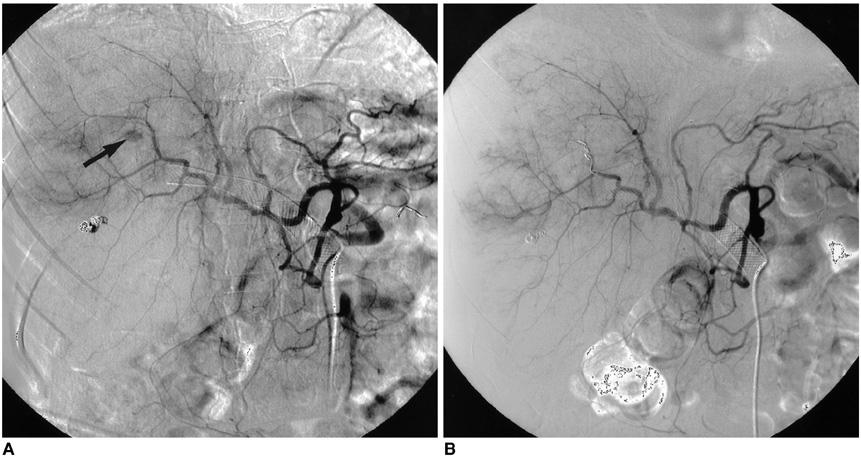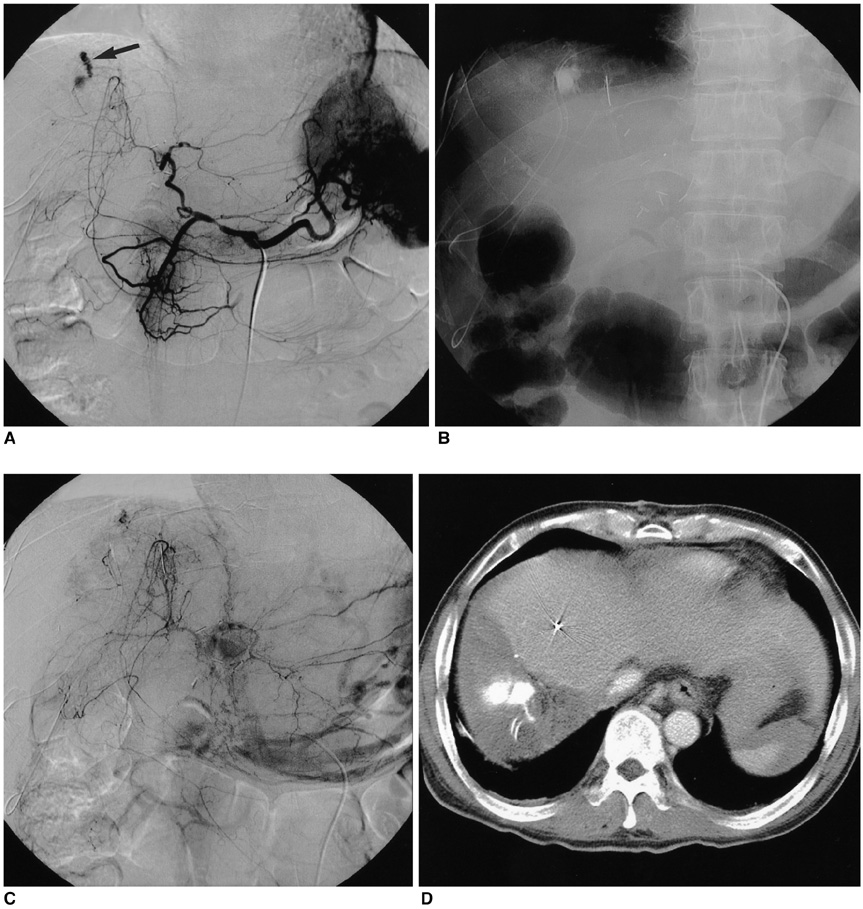Korean J Radiol.
2004 Sep;5(3):164-170. 10.3348/kjr.2004.5.3.164.
Causes of Arterial Bleeding After Living Donor Liver Transplantation and the Results of Transcatheter Arterial Embolization
- Affiliations
-
- 1Department of Radiology, Inha University, College of Medicine, Korea. kbs@www.amc.seoul.kr
- 2Department of Radiology, Asan Medical Center, University of Ulsan College of Medicine, Korea.
- 3Department of General Surgery, Asan Medical Center, University of Ulsan College of Medicine, Korea.
- KMID: 1118821
- DOI: http://doi.org/10.3348/kjr.2004.5.3.164
Abstract
OBJECTIVE
To analyze the causes of arterial bleeding after living donor liver transplantation (LDLT) and to evaluate the efficacy of transcatheter arterial embolization (TAE). MATERIALS AND METHODS: Forty-two sessions of conventional arteriography were performed in 32 of the 195 patients who underwent LDLT during the past 2 years. This was done in search of bleeding foci of arterial origin. TAE was performed with microcoils or gelatin sponge particles. The causes of arterial bleeding, the technical and clinical success rates of TAE and the complications were retrospectively evaluated. RESULTS: Forty-two bleeding foci of arterial origin were identified on 30 sessions of arteriography in 21 patients. The most common cause of bleeding was percutaneous procedures in 40% of the patients (17 of the 42 bleeding foci) followed by surgical procedures in 36% (15/42). The overall technical and clinical success rates of TAE were 21 (70%) and 20 (67%) of the 30 sessions, respectively. The overall technical success rate of TAE for the treatment of bleeding from the hepatic resection margin, hepatic artery anastomotic site and hepaticojejunostomy was only 18% (2/11), whereas for the treatment of bleeding in the other locations the technical and clinical success rates of TAE were 100% and 95%, respectively. No procedure-related major complications occurred. CONCLUSION: In the case of arterial bleeding after LDLT, percutaneous procedure-related hemorrhages were as common as surgery-related hemorrhages. There were technical difficulties in using TAE for the treatment of hepatic arterial bleeding. However, in the other locations, TAE seems to be safe and effective for the control of arterial bleeding in LDLT recipients.
Keyword
MeSH Terms
Figure
Reference
-
1. Raia S, Nery JR, Mies S. Liver transplantation from live donors. Lancet. 1989. 2:497.2. Samstein B, Emond J. Liver transplants from living related donors. Annu Rev Med. 2001. 52:147–160.3. Belghiti J, Durand F. Living donor liver transplantation: present and future. Br J Surg. 2000. 87:1441–1443.4. Ozaki CF, Katz SM, Monsour HP Jr, Dyer CH, Wood RP. Surgical complications of liver transplantation. Surg Clin North Am. 1994. 74:1155–1167.5. Testa G, Malago M, Broelsch CE. Bleeding problems in patients undergoing segmental liver transplantation. Blood Coagul Fibrinolysis. 2000. 11:S81–S85.6. Koneru B, Tzakis AG, Bowman J 3rd, Cassavilla A, Zajko AB, Starzl TE. Postoperative surgical complications. Gastroenterol Clin North Am. 1988. 17:71–91.7. Clavien PA, Camargo CA Jr, Croxford R, Langer B, Levy GA, Greig PD. Definition and classification of negative outcomes in solid organ transplantation. Application in liver transplantation. Ann Surg. 1994. 220:109–120.8. Nakajima I, Fuchinoue S, Tanaka K, et al. Clinical study of living-related liver transplantation. Transplant Proc. 1998. 30:138–141.9. Tojimbara T, Fuchinoue S, Nakajima I, et al. Factors affecting survival after living-related liver transplantation. Transpl Int. 2000. 13:S136–S139.10. Sauer IM, Pascher A, Steinmuller T, et al. Split liver and living donation liver transplantation: the Berlin experience. Transplant Proc. 2001. 33:1459–1460.11. Bell R, Sheil AG, Thompson JF, et al. Vascular complications following orthotopic liver transplantation. Aust N Z J Surg. 1990. 60:193–198.12. Patenaude YG, Dubois J, Sinsky AB. Liver transplantation: review of the literature part 2: vascular and biliary complications. Canad Assoc Radiol J. 1997. 48:231–242.13. de Villa VH, Chen CL, Chen YS, et al. Split liver transplantation in Asia. Transplant Proc. 2001. 33:1502–1503.14. Kirby RM, McMaster P, Clements D, et al. Orthotopic liver transplantation: postoperative complications and their management. Br J Surg. 1987. 74:3–11.15. Lebeau G, Yanaga K, Marsh JW, et al. Analysis of surgical complications after 397 hepatic transplantations. Surg Gynecol Obstet. 1990. 170:317–322.16. Madariaga J, Tzakis A, Zajko AB, et al. Hepatic artery pseudoaneurysm ligation after orthotopic liver transplantation - a report of 7 cases. Transplantation. 1992. 54:824–828.17. Marshall MM, Muiesan P, Srinivasan P, et al. Hepatic artery pseudoaneurysms following liver transplantation: incidence, presenting features and management. Clin Radiol. 2001. 56:579–587.18. Koep LJ, Starzl TE, Weil R 3rd. Gastrointestinal complications of hepatic transplantation. Transplant Proc. 1979. 11:257–261.
- Full Text Links
- Actions
-
Cited
- CITED
-
- Close
- Share
- Similar articles
-
- Outcomes and complications of embolization for gastrointestinal bleeding
- Hepatic Artery Reconstruction Using the Right Gastroepiploic Artery for Hepatic Artery Inflow in a Living Donor Liver Transplantation
- Transcatheter hepatic arterial embolization of ruptured hepatoma with massive intraperitoneal bleeding
- The Application of Interventional Radiology in Living-Donor Liver Transplantation
- Recurrent Post-Traumatic Adrenal Bleeding after Transcatheter Arterial Embolization: A Case Report




